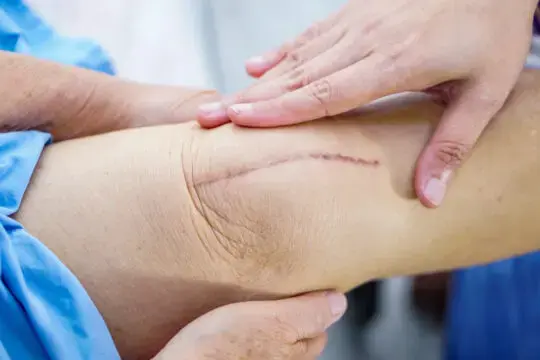How Scar Tissue Develops | Stages, Types & Care
Learn how scars form from injury to maturation, what affects their appearance
Scar tissue occurs when your skin is damaged. It is often difficult to prevent visible scar tissue. But how big and visible your final scar will be? You do have an influence on that. We give you all the information you need to treat your wound or existing scar tissue in the best possible way.
What is scar tissue?
Scar tissue is the connective tissue that your body forms in a wound. The larger the wound, the greater the risk of a visible (disfiguring) scar. This reaction is of course annoying, but normal and important: in this way, your body tries to repair the damage as quickly as possible, to protect you from infections and other harmful external influences.
Scar tissue can form anywhere on the body. For example:
On the abdomen after a caesarean section
On the face after a facelift
Near your eye, for example after an eyelid correction
At your lip due to a cleft lip
At the knee after knee surgery

What does scar tissue look like?
Scar tissue is often red and darker colored than the 'normal' skin around it. The scar skin may also be rougher, hardened or thickened. The size can vary from a bump to excessive scar growth to (far) beyond the edges of your wound.
Can scar tissue hurt?
Yes, you can suffer from scar tissue in different ways. For example, the skin can start to pull because the tissue is less supple than normal skin. As a result, the scar can certainly be painful or itchy.
What you can try in such a case is to massage the scar tissue. This way you can make it a bit more flexible again. Then you will also experience less pulling and pain. Can't get to the place properly? Then ask someone else to do the massage for you.
What does scar tissue consist of?
Scar tissue consists mainly of connective tissue. This is actually a high concentration of collagen fibers. Because that's the way your body tries to repair the skin quickly: by producing a lot of collagen. That is also the reason why scars are less supple and elastic than normal skin.
Causes of scars
Scars are basically caused by wounds. So make sure you always take good care of your wound. Especially for serious wounds such as:
Burns
Surgical wounds
Wounds after an accident
Plastic surgery
But you can also develop a scar after a piercing, for example. There are even cases of excessive scar tissue after piercing an earring.
Treating scar tissue
What can you do about scar tissue? First of all, you can do a lot with new wounds to prevent scars as much as possible. But even 'old' scars can be reduced with the right treatment.
Preventing scar tissue
You prevent scar tissue as much as possible by:
1. Take good care of your wound
2. Prevent fluid loss from the scar
3. Start scar treatment as soon as possible after wound closure
4. Good hydration of your skin means that your wound does not dry out and heals faster. As a result, you have less chance of (visible) scar tissue.
BAPSCARCARE's silicone therapy does exactly what we mention above. You can start therapy as soon as your wound is closed. We therefore recommend that you start immediately. Because your scar is still active for the first 1.5 to 2 years. During this period, you have the most influence on the occurrence of scar tissue.
Are you dealing with a smaller, more superficial wound, such as a scrape? Then a cream for scar tissue, such as ALHYDRAN, may be enough for you.
Reduce scar tissue
How does scar tissue go away once it has formed? It is important to know that scar tissue cannot be completely removed. You will always see something of the scar.
Although scar tissue cannot be completely removed, you can certainly reduce its visibility. You can also use BAPSCARCARE products for this.
Which BAPSCARCARE product will you choose?
That depends on the nature of your wound. That is why we have written an explanation for each product, so that you can discover for yourself which silicone product suits your scar.
Frequently asked questions
Yes, then you can. But this usually only happens years after the scar appears, and especially with larger scars. Be especially aware of changes: sudden growth, color change, bleeding or ulcers, sudden pain, etc. Then go to your doctor immediately.
For this reason, too, it is important to continue to take good care of existing scar tissue. For example, by protecting it from the sun.
Yes, scar tissue can grow excessively. We therefore speak of a keloid or hypertrophic scar. If you see a proliferation, it is very important to take immediate action. Silicone therapy is essential. The sooner you start, the more you can limit this growth.
No, scar tissue does not go away on its own. However, you can use scar cream or silicone therapy to reduce visibility.
You can also go to the hospital for so-called 'pressure therapy'. Then you will be given a mask or tailor-made clothing, which reduces the blood flow to your healing scar. This flattens the scar. It also itches less.
Silicone therapy and pressure therapy are two non-invasive (non-interventional) treatment methods for the treatment of scars that are accepted worldwide and for which there is the most scientific evidence.
Scar tissue often feels stiff and rough. Very different from ordinary, healthy skin.
